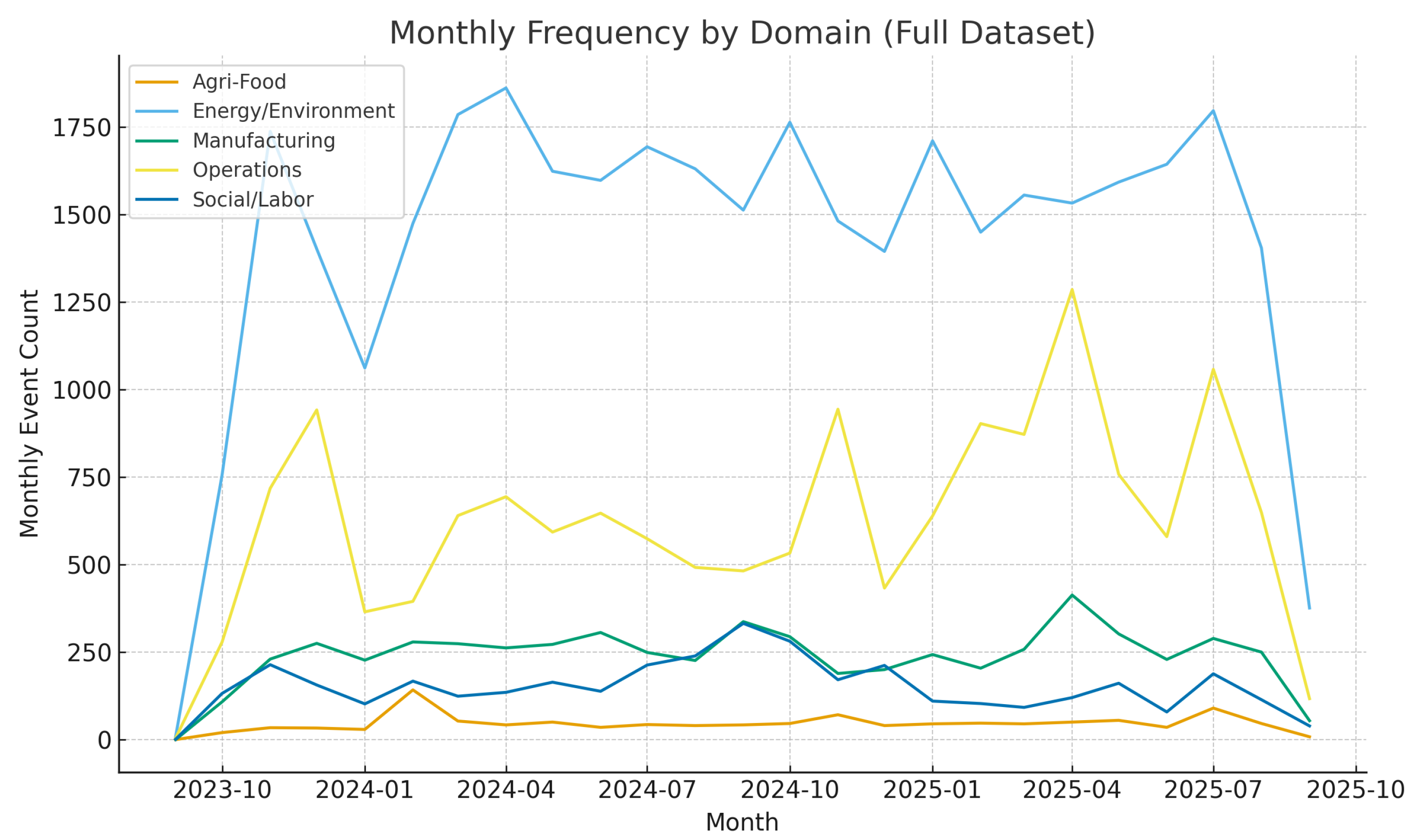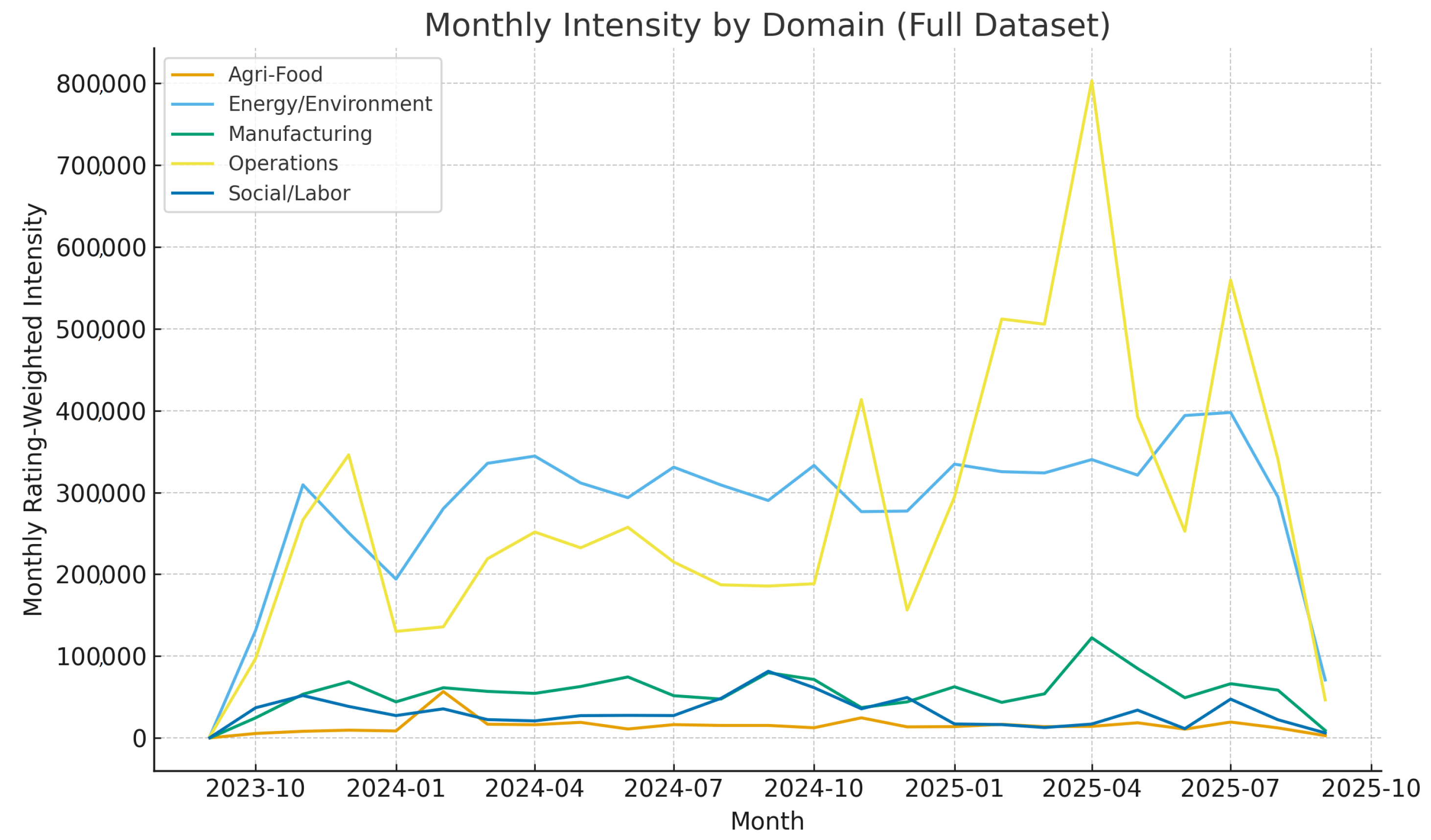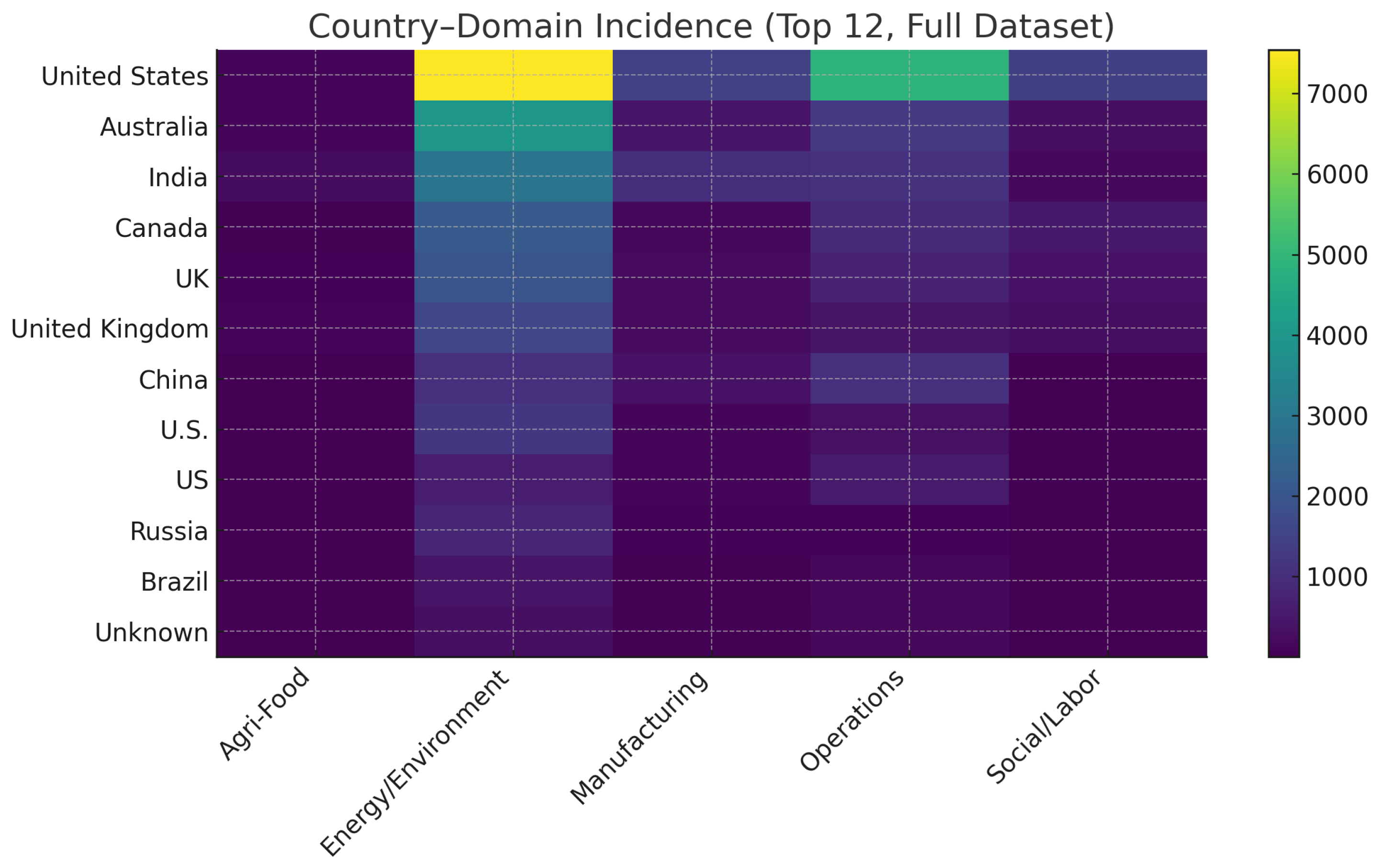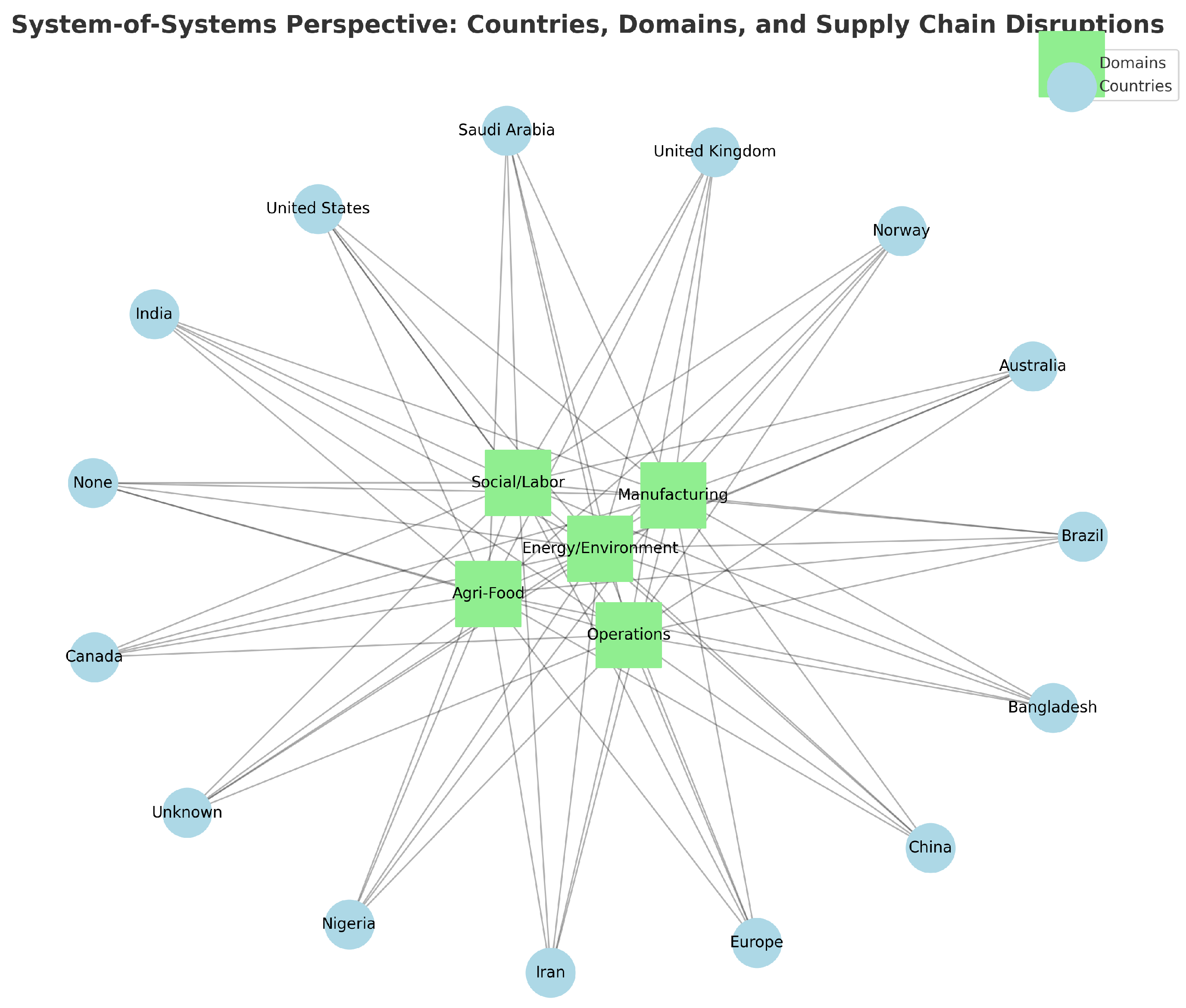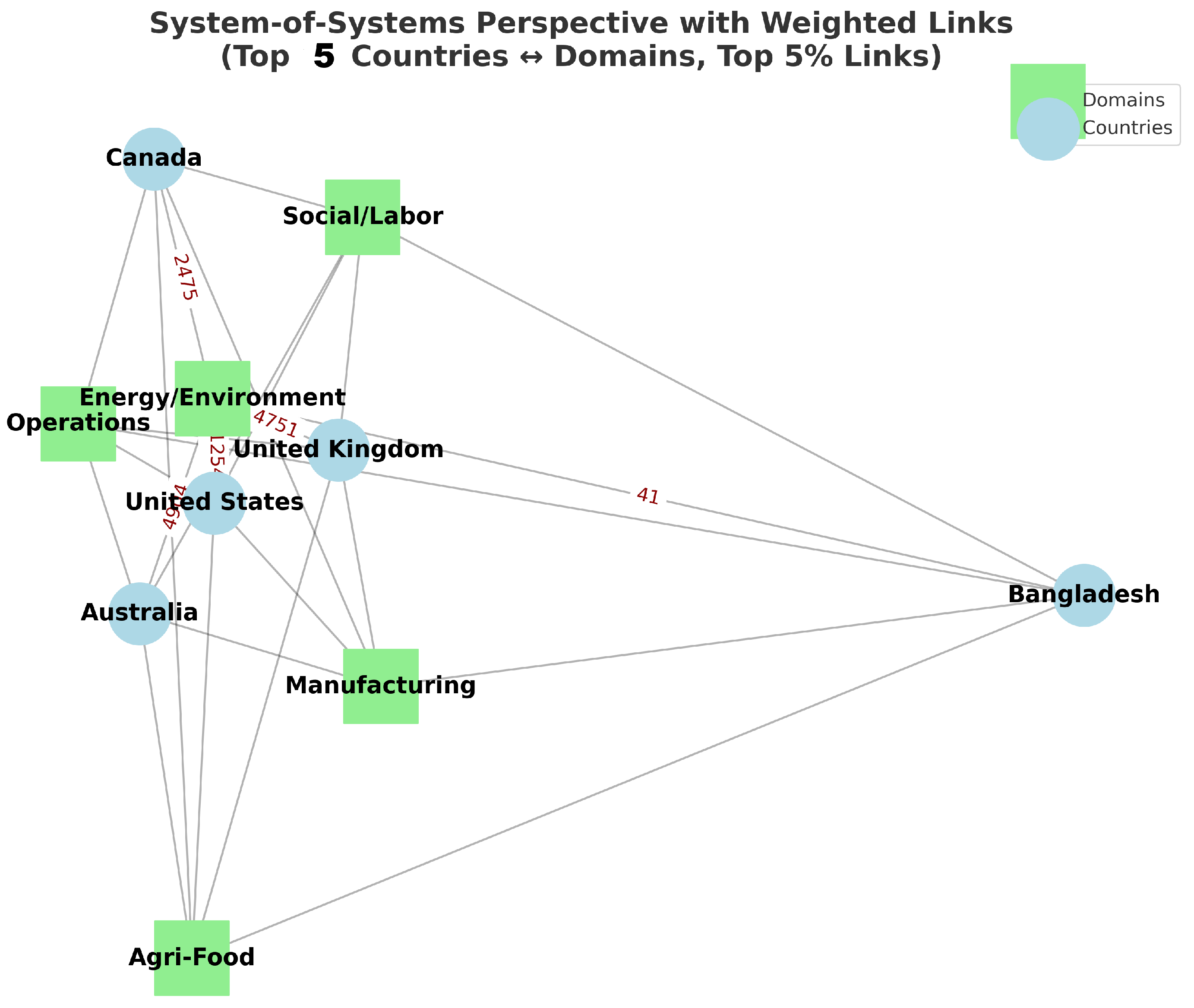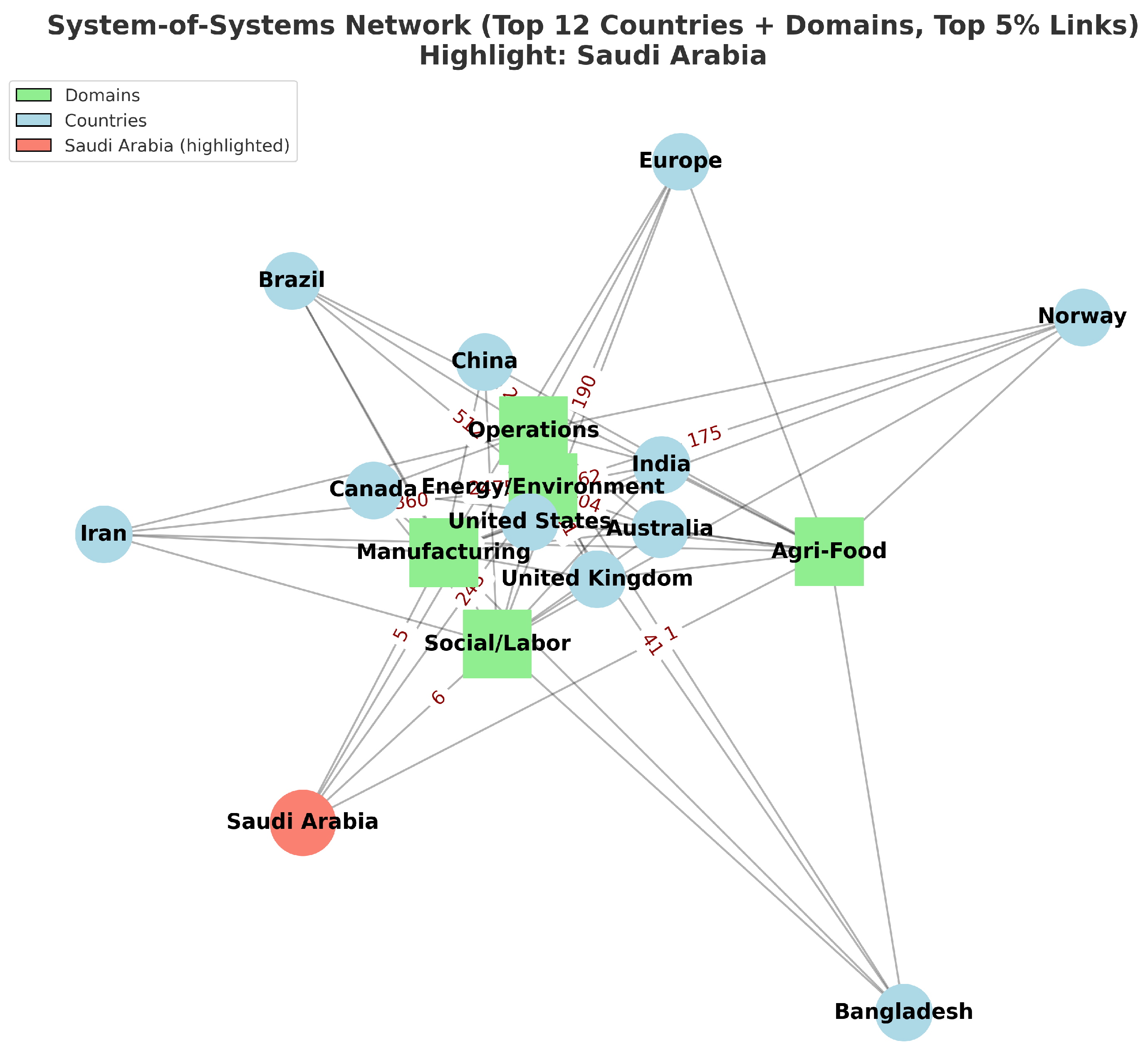Author Contributions
Conceptualization, F.S.; methodology, F.S.; software, F.S. and M.A.; validation, F.S.; formal analysis, F.S.; investigation, F.S.; resources, M.A.; data curation, F.S.; writing—original draft preparation, F.S.; writing—review and editing, F.S. and M.A.; visualization, F.S.; supervision, M.A.; project administration, M.A.; funding acquisition, M.A. All authors have read and agreed to the published version of the manuscript.
Figure 1.
Conceptual system-of-systems representation of global green supply chain disruptions. The figure illustrates how environmental, energy, logistics, manufacturing, agri-food, and labor domains are interdependent, showing how shocks in one domain cascade across others.
Figure 1.
Conceptual system-of-systems representation of global green supply chain disruptions. The figure illustrates how environmental, energy, logistics, manufacturing, agri-food, and labor domains are interdependent, showing how shocks in one domain cascade across others.
Figure 2.
Conceptual framework of the methodology. The figure illustrates the transformation of raw news event data into categorized domains, temporal and correlation analysis, system dynamics modeling of disruptions and resilience, and network analysis of event–country relationships.
Figure 2.
Conceptual framework of the methodology. The figure illustrates the transformation of raw news event data into categorized domains, temporal and correlation analysis, system dynamics modeling of disruptions and resilience, and network analysis of event–country relationships.
Figure 3.
Interaction of the four core algorithms: data ingestion and categorization (Algorithm 1), temporal aggregation (Algorithm 2), resilience index calibration (Algorithm 3), and geo-relational network construction (Algorithm 4).
Figure 3.
Interaction of the four core algorithms: data ingestion and categorization (Algorithm 1), temporal aggregation (Algorithm 2), resilience index calibration (Algorithm 3), and geo-relational network construction (Algorithm 4).
Figure 4.
Experimentation pipeline: collection and LLM-based classification of the news corpus; filtering to green supply chain event codes; domain mapping; descriptive statistics and geo-normalization; monthly aggregation to and ; and downstream system-dynamics and network analyses (resilience, couplings, hubs).
Figure 4.
Experimentation pipeline: collection and LLM-based classification of the news corpus; filtering to green supply chain event codes; domain mapping; descriptive statistics and geo-normalization; monthly aggregation to and ; and downstream system-dynamics and network analyses (resilience, couplings, hubs).
Figure 5.
Monthly frequency of supply chain disruptions across systemic domains. The figure highlights how Operations and Energy/Environment consistently dominate disruption frequency, reflecting their systemic vulnerability relative to other domains.
Figure 5.
Monthly frequency of supply chain disruptions across systemic domains. The figure highlights how Operations and Energy/Environment consistently dominate disruption frequency, reflecting their systemic vulnerability relative to other domains.
Figure 6.
Monthly rating-weighted intensity of supply chain disruptions across systemic domains. Energy/Environment shows the most volatile and severe spikes, particularly during climate-related and energy crises, underscoring its systemic fragility.
Figure 6.
Monthly rating-weighted intensity of supply chain disruptions across systemic domains. Energy/Environment shows the most volatile and severe spikes, particularly during climate-related and energy crises, underscoring its systemic fragility.
Figure 7.
Estimated resilience indices for each systemic domain (full dataset). The figure demonstrates that Agri-Food and Social/Labor display the highest adaptive capacity, while Energy/Environment and Operations remain the most fragile, reflecting systemic weaknesses.
Figure 7.
Estimated resilience indices for each systemic domain (full dataset). The figure demonstrates that Agri-Food and Social/Labor display the highest adaptive capacity, while Energy/Environment and Operations remain the most fragile, reflecting systemic weaknesses.
Figure 8.
Domain-specific incidence of supply chain disruptions across the top 12 countries (full dataset, standardized country names). The figure shows that the United States and Australia are heavily exposed in Operations and Energy/Environment, whereas India and China display more balanced exposure across domains.
Figure 8.
Domain-specific incidence of supply chain disruptions across the top 12 countries (full dataset, standardized country names). The figure shows that the United States and Australia are heavily exposed in Operations and Energy/Environment, whereas India and China display more balanced exposure across domains.
Figure 9.
System-of-systems perspective of global green supply chain disruptions. Countries (blue nodes) are linked to systemic domains (green squares), illustrating multi-domain exposure and interdependencies.
Figure 9.
System-of-systems perspective of global green supply chain disruptions. Countries (blue nodes) are linked to systemic domains (green squares), illustrating multi-domain exposure and interdependencies.
Figure 10.
System-of-systems network showing the top 5 countries and their top 5% strongest disruption linkages with systemic domains. Strong interdependencies with Energy/Environment and Operations dominate, particularly for the United States and United Kingdom.
Figure 10.
System-of-systems network showing the top 5 countries and their top 5% strongest disruption linkages with systemic domains. Strong interdependencies with Energy/Environment and Operations dominate, particularly for the United States and United Kingdom.
Figure 11.
System-of-systems network of the top 12 countries, highlighting Saudi Arabia (red node). Link values show that Saudi Arabia’s strongest dependency is on the Energy/Environment domain (>300 events), followed by weaker connections to Operations (<50 events).
Figure 11.
System-of-systems network of the top 12 countries, highlighting Saudi Arabia (red node). Link values show that Saudi Arabia’s strongest dependency is on the Energy/Environment domain (>300 events), followed by weaker connections to Operations (<50 events).
Table 1.
Research gaps in the green supply chain management literature.
Table 1.
Research gaps in the green supply chain management literature.
| Theme | State of the Art | Identified Gap |
|---|
| Strategic Role of GSCM | GSCM practices enhance competitiveness and sustainability [1,3,4] | Fragmented, top-down discourse with limited inclusiveness [6] |
| Performance and Stakeholders | Supplier-focused metrics dominate [2] | Neglect of customer, labor, and community perspectives |
| Barriers to Adoption | Costs, immature technologies, and regulations limit adoption [5] | Lack of global systemic analyses linking barriers to resilience |
| Event-Coded Data | Structured signals from Factiva and EventWatch [9,10,22] | Limited integration with resilience and system-dynamics models |
| Simulation and System Dynamics | EST and simulation capture persistence/spillovers [7,8] | Weak empirical validation; limited cross-domain application |
| Real-Time Monitoring | Event studies and SCEM provide disruption detection [18,19,20,21] | Lack of integration with predictive and adaptive frameworks |
| Critical Hubs | US, Belgium, Chile, China identified as chokepoints [11,12,13] | Absence of integrated frameworks linking hubs with systemic resilience |
| Cross-Domain Coupling | Energy, agri-food, labor disruptions cascade [28,29] | Limited holistic, system-of-systems validation |
| Reviews and Synthesis | Systematic reviews of disruptions and resilience [14,15,16] | Need for synthesis integrating empirical event data with systemic models |
| Predictive Analytics and AI | Machine learning supports forecasting and disruption management [23,24,25,26,27,30,31,32,33] | Insufficient application to GSCM-specific disruption modeling |
Table 2.
Notation and variable definitions.
Table 2.
Notation and variable definitions.
| Symbol | Definition |
|---|
| Set of events in the dataset |
| Set of K event categories (supply chain domains) |
| Event date of |
| Event significance (local, national, international) |
| Event rating (quantitative impact score) |
| First and second event country |
| Frequency of events in category c at time t |
| Aggregated rating of category c at time t |
| Correlation between categories and |
| Resilience index of category c |
Table 3.
Overview of dataset coverage and structure.
Table 3.
Overview of dataset coverage and structure.
| Characteristic | Value |
|---|
| Total records (filtered, event-coded) | 67,434 |
| Temporal coverage | 26 September 2023 to 9 September 2025 |
| Distinct event codes | 23 |
| Mapped systemic domains | 5 |
| Ratings available (non-missing) | 66,357 |
| Ratings missing | 1077 |
| Distinct normalized countries | 1390 |
Table 4.
Distribution of event codes in the analytical dataset.
Table 4.
Distribution of event codes in the analytical dataset.
| Event Code | Count |
|---|
| Energy and Resource News | 17,748 |
| Environmental News | 15,944 |
| Climate Change Report | 8246 |
| Electric and Self driving Vehicles news | 5083 |
| Trade and Commerce | 3728 |
| Hazardous Industrial Accident | 2817 |
| Manufacturing and Engineering News | 2664 |
| Workers on Strike | 2522 |
| Food Supply and Inventory Event | 1720 |
| Significant Farming News or Event | 1141 |
| Labor and Employment News | 926 |
| Logistics News | 859 |
| Energy Grid and Distribution | 726 |
| Fuel related price hikes | 698 |
| Oil and Gas Industry | 665 |
| Rare Earth Elements Industry News | 571 |
| International Supply Chain Event | 346 |
| Workers Rights | 339 |
| Major Product Recall | 331 |
| Manufacturing Related News | 158 |
| Energy Storage News | 143 |
| Global Environmental Contamination News | 58 |
| Environmental news (variant) | 1 |
Table 5.
Distribution of events across systemic domains.
Table 5.
Distribution of events across systemic domains.
| Domain | Count |
|---|
| Energy/Environment | 44,102 |
| Operations | 10,714 |
| Manufacturing | 5970 |
| Social/Labor | 3787 |
| Agri-Food | 2861 |
Table 6.
Distribution of event significance labels (after harmonization).
Table 6.
Distribution of event significance labels (after harmonization).
| Event Significance (Raw) | Count |
|---|
| Local | 18,027 |
| National | 18,258 |
| International | 15,842 |
| Global | 8286 |
| State | 3851 |
| Region | 1627 |
| Community | 1149 |
| Regional | 271 |
Table 7.
Descriptive statistics for event ratings.
Table 7.
Descriptive statistics for event ratings.
| Statistic | Value |
|---|
| Count | 66,357 |
| Mean | 275.06 |
| Standard deviation | 217.07 |
| Minimum | 6.30 |
| 25th percentile | 118.56 |
| Median | 227.52 |
| 75th percentile | 353.92 |
| 90th percentile | 586.44 |
| 95th percentile | 747.84 |
| Maximum | 1236.60 |
Table 8.
Top 10 countries after normalization of name variants.
Table 8.
Top 10 countries after normalization of name variants.
| Country | Count |
|---|
| United States | 20,829 |
| United Kingdom | 6716 |
| Australia | 6448 |
| India | 5616 |
| Canada | 3834 |
| China | 3671 |
| Russia | 973 |
| Unknown | 640 |
| Brazil | 613 |
| Germany | 589 |
Table 9.
Sample of monthly frequency and rating-weighted intensity across domains (Agri-Food domain, 10 months).
Table 9.
Sample of monthly frequency and rating-weighted intensity across domains (Agri-Food domain, 10 months).
| Month | Domain | Frequency | Intensity |
|---|
| 2023-10 | Agri-Food | 20 | 5375.52 |
| 2023-11 | Agri-Food | 34 | 8046.00 |
| 2023-12 | Agri-Food | 33 | 9392.22 |
| 2024-01 | Agri-Food | 29 | 8467.92 |
| 2024-02 | Agri-Food | 142 | 56,594.70 |
| 2024-03 | Agri-Food | 53 | 16,679.70 |
| 2024-04 | Agri-Food | 42 | 16,081.56 |
| 2024-05 | Agri-Food | 50 | 18,958.32 |
| 2024-06 | Agri-Food | 35 | 10,861.20 |
| 2024-07 | Agri-Food | 43 | 16,199.46 |
Table 10.
Resilience metrics estimated for each systemic domain using the system-dynamics model. The table highlights that Agri-Food and Social/Labor exhibit stronger recovery capacity, while Operations and Energy/Environment show minimal resilience, indicating systemic fragility.
Table 10.
Resilience metrics estimated for each systemic domain using the system-dynamics model. The table highlights that Agri-Food and Social/Labor exhibit stronger recovery capacity, while Operations and Energy/Environment show minimal resilience, indicating systemic fragility.
| Domain | | | | | |
|---|
| Agri-Food | −0.33 | 1.00 | 0.31 | 0.39 | 1.43 |
| Social/Labor | −0.65 | 1.00 | 1.26 | 0.03 | 0.77 |
| Manufacturing | −1.27 | 1.00 | 1.49 | 0.39 | 0.53 |
| Energy/Environment | 0.98 | 0.02 | 0.00 | 0.32 | 0.05 |
| Operations | 1.34 | 0.00 | 0.00 | 0.77 | 0.00 |
Table 11.
Comparative perspective of existing approaches in GSCM research versus the present study. The table shows how this research addresses gaps by integrating large-scale event-coded datasets with system-of-systems resilience modeling, enabling cross-domain and geo-relational insights.
Table 11.
Comparative perspective of existing approaches in GSCM research versus the present study. The table shows how this research addresses gaps by integrating large-scale event-coded datasets with system-of-systems resilience modeling, enabling cross-domain and geo-relational insights.
| Study/Approach | Key Contributions | Limitations Addressed by Present Study |
|---|
| Zhu and Cote (2004) [1] | Strategic role of environmental practices in supply chains | Firm- and sector-level focus; lacks global, systemic scope |
| Chen et al. (2017) [2] | Supplier-focused performance metrics (financial, operational, ecological) | Neglect of customer, labor, and social dimensions |
| Ramirez-Peña et al. (2020) [3] | Integration of sustainability into industrial systems | Limited empirical validation at global scale |
| Liu et al. (2024) [5] | Barriers: costs, immature technologies, regulatory burden | Absence of resilience modeling and systemic perspective |
| Wang et al. (2025) [6] | Narrative analysis of GSCM, highlighting top-down policy influence | Lack of empirical event-based evidence; limited inclusiveness |
| Love (2021), Peng (2021) [9,10] | Use of event-coded disruption signals for monitoring | Weak integration into system-dynamics resilience frameworks |
| Samani (2020), Papanagnou (2022) [7,8] | Simulation and event system theory for disruption modeling | Conceptual/simulation-driven; limited empirical grounding |
| Hart-Nibbrig (2025), Meng (2025), Zhao (2025) [11,12,13] | Identification of disruption hubs and chokepoints | Narrower datasets; limited cross-domain coupling |
| Present Study | Large-scale event-coded dataset (>67,434 events), system-of-systems modeling, resilience indices, cross-domain coupling, geo-relational hubs | Provides global empirical validation, integrates event-coded data with resilience modeling, captures multi-domain and geographic interdependencies |




